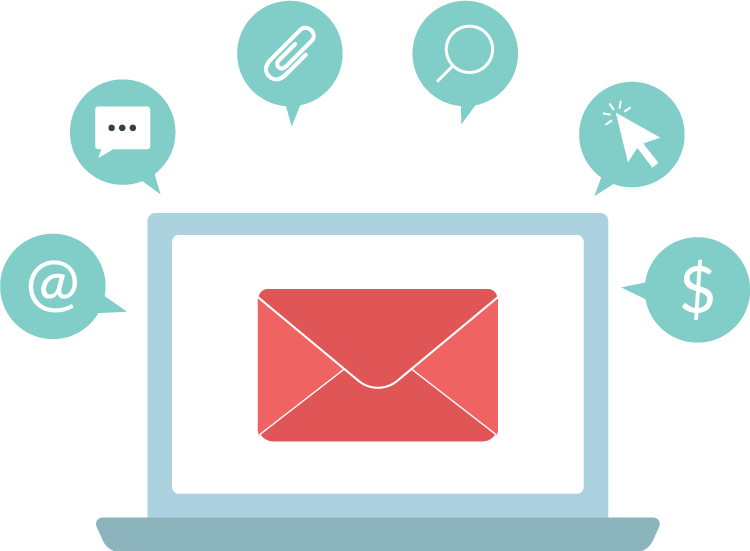This article originally appeared on the Prime Design Solutions website.
Table of contents
Related articles
Email marketing is one of the oldest forms of digital marketing, and one of the most popular. In fact, one study estimated that more than 838 billion (BILLION!) e-mails were sent in 2013 alone. Given the sheer volume of marketing email out there – and how crowded your own in-box might be – it might be tempting to dismiss email marketing as outmoded, overdone, and not worth your time. But in fact, email marketing is incredibly effective – according to the Direct Marketing Association, it has an ROI of 4,300%.
8 things to know about e-mail marketing today
- Your email list is all yours. Building a fan or follower base on social media like Facebook, Twitter, and Google + is an important part of most companies’ marketing strategies. However, as the recent, dramatic drop in the organic reach of Facebook Page posts illustrates, building an audience on social media is like building a house on rented ground – you are always at the mercy of the social medium itself, and the rules of engagement may change at any time without warning. When you build your email list, you’re building something that will always work, and you own it outright.
- However, building an email list takes time and effort. There are a variety of ways to build your list — here are a few ways to consider:
- Make it easy to sign up on your website. Generally speaking, the less information you require people to fill in, the more they’ll sign up. Some websites even include a special landing page designed to get the viewer to sign up.
- Promise special offers – either one-time or on an ongoing basis – as an incentive. Depending on your business, you can offer something special for people signing up. For B2Bs, this might be a something like a white paper or access to particularly valuable industry information – for business-to-consumer, a promotional goodie like a coupon or special offer.
- If you have a physical location, collect email addresses there. Make it clear that you’ll add them to your email list, what they can expect from your newsletter (special promotions, advance notice of sales, industry news, or whatever), and how often they will hear from you.
- Encourage people to share your e-mails by including a “forward to a friend” button. Most e-mail services will include this as an option when you’re building an e-mail newsletter.
- Collect email addresses at trade shows and other industry events. Again, make it clear that people are opting in when they give you their business card or otherwise sign up.
- People change their email addresses more often than you may realize. People change jobs, move, switch Internet service providers, and sign up for different email services frequently — 31% change their e-mail annually, according to one study. So building your email list is an ongoing task, not a one-time proposition.
- Do NOT buy a list – that’s spam. It’s possible to buy email lists, but using a bought list almost certainly violates the terms of service of the email company you’re using and of your Internet service provider. When you send unsolicited bulk email to people who have not opted in to your list, you’re sending spam. (Similarly, you should never share your email list with any other entity.)
- It’s an important form of content marketing. Content marketing is educating customers and prospects about topics important to your industry as a way of building trust and cultivating relationships. Email marketing is a great form of content marketing, ideally suited to share industry news and other information that’s helpful to your customers, and to drive traffic to new blog posts on your website. Like content marketing in general, email marketing works for B2Bs as well as business-to-consumer.
- It’s incredibly inexpensive. There are a variety of services that offer email marketing for fairly nominal charges, or even for free. Contrast that with direct mail, which includes costs to design, print, and mail.
- It’s really fast. Email marketing can be rushed out the door in a way that virtually no other form of marketing can. You can use it to promote last-minute sales, reinforce advertising campaigns, inform about breaking industry news, or anything that’s especially timely.
- The subject line is the most important part of the email. Your subject line should be relatively brief – 30-50 characters. Good subject lines accurately reflect what’s contained in the email, and get people’s attention while giving them a reason to open the email. Depending on the goal of your email, an effective subject line might:
- Tout promotional offers contained in the email — this can increase open rates up to 50%
- Contain words like “news” or anything that creates a sense of urgency.
- Tease slightly – for example, stating “our new collection is here…and it’s the prettiest one yet!” imparts roughly the same information as, “now in stock: new collection,” but is more enticing. What new collection? Why is it the prettiest one?
- However, you should avoid:
- USING ALL CAPS
- Too much punctuation, such as multiple exclamation points
- Misleading information
- Choose your timing wisely. At least 91% of people check their email accounts once a day, but when to send an email campaign is an important consideration. Mornings and early afternoons are generally considered better emailing times to maximize your open rate. Avoid weekends.
- Optimize for mobile if at all possible. A study has indicated that 35% of businesspeople check email on their mobile phones, and 64% of decisionmakers read email on mobile – and these numbers are likely to increase as the mobile market continues to explode. If your email is opened on a mobile device but isn’t optimized, it’ll probably get deleted.


